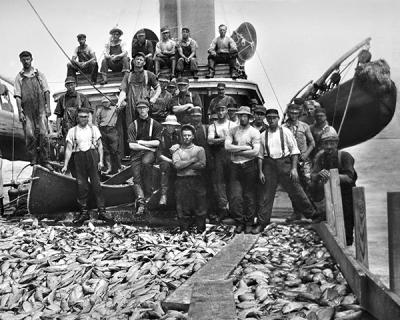Nature Notes: Bunker on the Wind

Long Island had two big fish kills in its inshore waters last week — one in Manhasset Bay, another in the western part of the Peconic Estuary. These two kills involved a single species that is famous for its periodic mass die-offs up and down the Atlantic Coast — the menhaden, Brevoortia tyrannus. These massive kills of thousands upon thousands of fish do not occur at regular intervals. They are most likely to occur when the population of young menhaden 1 to 3 years old reach such massive numbers when plying shallow waters for food that they quickly exhaust the dissolved oxygen supply and commit a kind of mass suicide.
Menhaden, also called mossbunker, and porgy belong to the herring family, the Clupeidae, along with shads, alewives, and gizzard shads. Members of this family are filter feeders; they use their feathery gills not only to extract oxygen, but also phytoplankton and zooplankton, from the water. They are the vacuum cleaners of the sea and can on occasion exhaust their food and oxygen supply, after which there is nothing for them to do but bite the dust en masse.
This fish helped build the reputation of East Hampton’s elite fisherman population. In the latter part of the 19th century and early part of the 20th, there were quite a few bunker-rendering factories including ones on Hick’s Island and at Promised Land on Gardiner’s Bay, now the home of Multi Aquaculture Systems. The last of these went out of business in the 1960s when the government imposed strong take restrictions on harvesting bunker, as the middle Atlantic bunker population had practically collapsed.
In 1979 the then owners, the Clarkes, sold the site and a large portion of the remaining undeveloped land in Napeague, which stretched from the bay south to the Atlantic Ocean, to the State of New York. It became Napeague State Park.
Serendipitously, the odors produced at the menhaden-rendering site when it was working were the best defense ever devised against developing a large piece of raw real estate such as the Napeague isthmus. As soon as it went out of business, the parcels along Cranberry Hole Road and those south of Montauk Highway were quick to be built on. A kind of Coney Island atmosphere came into being and Napeague became one of the prime centers of attention of the real estate industry in East Hampton Town.
Menhaden are very oily fish. Their bodies were separated into oil and fish parts, the bulk of which were used as fertilizer. The name menhaden is said to derive in part from the Atlantic Coast Native American name for fertilizer, “munnauhateaug.” The local Indians taught the early settlers how to use the fish to fertilize corn and other crop plants. The coastal fishermen followed the bunker schools up and down the coast — as did the whales, dolphins, bluefish, striped bass, and sharks — and captured them in large purse seines worked by several boats at a time. It was kind of like haulseining with nets a quarter of a mile long. The fishermen worked together to make hauls and divided up the spoils democratically.
Unfortunately, those days are gone forever. Science and politics put an abrupt end to them. But the mossbunkers live on. In a way, they are like the sand eels, the much tinier fish that will reproduce in the millions and millions and start the plant-to-animal food chain, which ends in the stomachs of the top predators — tunas, marlins, sharks, and the like. As Stuart Vorpahl is quick to point out, such cycles of “glut” and “want” have been going on for centuries, starting long before any semblance of modern civilization.
It’s the way that the ocean works, or at least used to work.
In the last century and this one, fishery scientists and others have made extreme efforts to try to even out the fluctuations in the hopes of producing large quantities of harvestable seafood year round, century round, in the way that farms and ranches maximize output on an annual basis.
At the same time, science and regulation have collided with human overpopulation, grand scale pollution, wars, and the other negative accoutrements of modern civilization, producing a kind of flattening out of the highs and lows of natural production while coincidentally contaminating the seafood with mercury, bacteria, viruses, and other harmful agents.
Yes, there are lots of ways to make things better on land and in the seas, and we are diligently working to do that. We need to get rid of the Pacific and Atlantic gyres of plastic bits, the microbeads, the PCBs, the pentas and C.C.A.s, and all of the other baddies that are poisoning our world. On the other hand, trying to govern the way things work in the world’s oceans according to some preconceived model for the benefit of man has little chance of succeeding. Perhaps, when we stop killing each other on all of the lands bordering those oceans, we can take on such a difficult task.
In the meanwhile, the menhaden, which may not be as smart as we are but are far wiser in an evolutionary sense, will come and go as they always have.
Larry Penny can be reached via email at [email protected].
